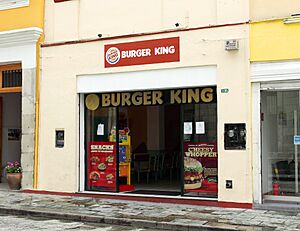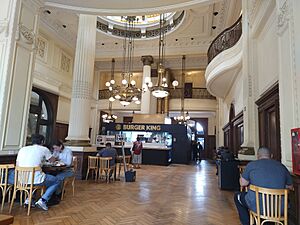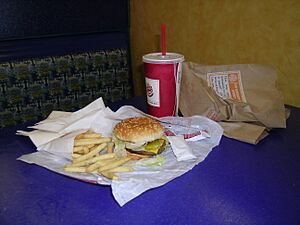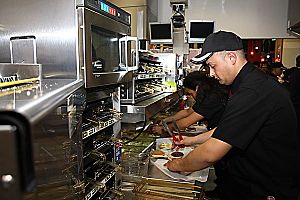Burger King facts for kids
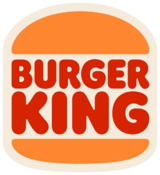
Logo used since 2020
|
|
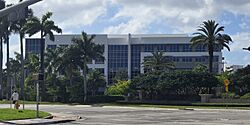
Corporate headquarters in Miami-Dade County, Florida
|
|
| Subsidiary | |
| Industry | Restaurants |
| Genre | Fast food restaurant |
| Founded | Insta-Burger King: 1953 Jacksonville, Florida, U.S. Burger King: 1954 Miami, Florida, U.S. |
| Founder | Insta-Burger King: Keith G. Cramer and Matthew Burns Burger King: David Edgerton and James McLamore |
| Headquarters | 5707 Blue Lagoon Drive, Miami-Dade County, Florida, U.S. |
|
Number of locations
|
|
|
Area served
|
Global |
|
Key people
|
|
| Products |
|
| Revenue |
|
| Parent | Pillsbury (1967–1989) Grand Metropolitan (1989–1997) Diageo (1997–2002) TPG Inc. (2002–2010) 3G Capital (2010–2014) Restaurant Brands International (2014–present) |
Burger King Corporation, often called BK, is a big American company that runs a chain of hamburger fast food restaurants. Its main office is in Miami-Dade County, Florida. The company started in 1953 as Insta-Burger King in Jacksonville, Florida.
After Insta-Burger King faced money problems, two people who owned Burger King restaurants in Miami, David Edgerton and James McLamore, bought the company in 1959. Over the next 50 years, the company was sold four times. In 2002, a group of owners made it a public company, meaning its shares could be bought and sold by anyone. In 2010, a Brazilian company called 3G Capital bought most of Burger King for about $3.26 billion. The new owners quickly started to make big changes to improve the company. Later, 3G Capital joined with another company, Berkshire Hathaway, and merged Burger King with a Canadian coffee shop chain called Tim Hortons. They formed a new parent company in Canada called Restaurant Brands International.
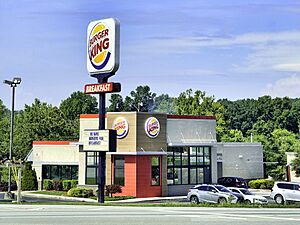
Burger King's menu has grown a lot from just burgers, fries, sodas, and milkshakes. In 1957, the "Whopper" was added and quickly became Burger King's most famous item. The company has also tried many new products that didn't become popular in the United States, but some of these were successful in other countries. Burger King also changes its menu in different parts of the world to fit local tastes. From 2002 to 2010, Burger King focused on attracting young men aged 18–34 with larger, often less healthy, food items. This approach eventually hurt the company's finances. Starting in 2011, Burger King changed its strategy and began offering new menu items, improving existing products, and updating packaging as part of 3G Capital's plans to fix the company.
By the end of 2018, Burger King had 17,796 restaurants in 100 countries. Almost half of these are in the United States. Most Burger King restaurants (99.7%) are owned and run by independent business owners, called franchisees. This is because the new owners decided in 2013 to have almost all restaurants run by franchisees. Burger King has used different ways to let people open their restaurants. Sometimes, a larger company, called a master franchise, is in charge of selling smaller licenses in a certain area. Burger King and its franchisees have not always gotten along, leading to disagreements and even court cases. Burger King's Australian restaurants are called Hungry Jack's because of a name dispute with another restaurant there.
Contents
History of Burger King
The company that came before Burger King started in 1953 in Jacksonville, Florida, and was called Insta-Burger King. The founders, Keith G. Cramer and Matthew Burns, visited the McDonald brothers' first restaurant in San Bernardino, California. They bought the rights to use two special cooking machines, including one called the "Insta-Broiler." This machine cooked burgers very well, and they made sure all their franchised restaurants used it.
Early Ownership and Growth
When the company faced money problems in 1959, it was bought by two of its restaurant owners from Miami, James McLamore and David R. Edgerton. They changed the company's name to Burger King. They ran the company on their own for eight years, growing to over 250 locations in the United States. In 1967, they sold Burger King to the Pillsbury Company.
Pillsbury tried to improve Burger King several times in the late 1970s and early 1980s. A big change happened in 1978 when Burger King hired Donald N. Smith, an executive from McDonald's. He made many changes to how the company worked, including new agreements for franchisees, a bigger menu, and new restaurant designs. Smith left Burger King in 1980, and sales started to drop.
Norman E. Brinker, another Pillsbury executive, was then given the job of making Burger King stronger against its main rival, McDonald's. He started new advertisements that directly compared Burger King to its competitors. This began a period of strong competition between Burger King, McDonald's, and other burger chains, known as the Burger wars. Brinker left Burger King in 1984.
Smith and Brinker's efforts helped at first. But after they left, Pillsbury stopped many of their changes and built fewer new restaurants. This slowed down the company's growth, and sales dropped again, causing financial trouble for Burger King and Pillsbury. Poor management continued to affect the company for many years.
Changes in Ownership and Challenges
In 1989, a British company called Grand Metropolitan bought Pillsbury. Grand Met tried to make Burger King profitable, but the results were mixed. They introduced successful new products and partnered with The Walt Disney Company, but the company still had image problems and ineffective advertising. In 1992, Burger King's main office was badly damaged by Hurricane Andrew.
After Grand Met, a series of CEOs tried to fix Burger King by changing the menu and advertising. However, the company's owners continued to neglect the brand, which hurt many franchisees and lowered the company's overall value. Eventually, Diageo, the company formed when Grand Metropolitan merged with Guinness in 1997, decided to sell Burger King in 2000 because it was losing money.
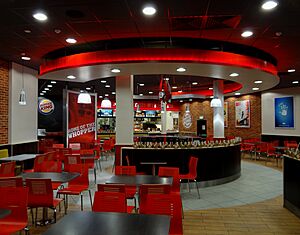
In 2002, Burger King became an independent company again when a group of investment firms, led by TPG Capital, bought it for $1.5 billion. The new owners quickly worked to improve the company. In 2006, they made Burger King a public company again, which was very successful. Their plan included new advertising, a new menu strategy, programs to update individual stores, a new restaurant idea called the BK Whopper Bar, and a new design called 20/20. These changes helped the company become profitable again.
However, the Great Recession (a period of economic difficulty) weakened Burger King's financial situation, while McDonald's continued to grow. Because Burger King's value dropped, TPG and its partners sold their share to 3G Capital of Brazil for $3.26 billion in 2010. After this deal, Burger King's stock was no longer traded on the New York Stock Exchange. This allowed the company to focus on improving its business without worrying about pleasing shareholders. In the United States, Burger King fell to third place in sales, behind McDonald's and Wendy's.
In August 2014, 3G Capital announced plans to buy the Canadian coffee and restaurant chain Tim Hortons and merge it with Burger King. This was supported by Warren Buffett's Berkshire Hathaway. Both chains continued to operate separately, with Burger King staying in Miami. This merger created the third-largest fast food company in the world. The deal caused some discussion because it involved moving the company's headquarters to Canada, which has lower taxes. Some U.S. politicians were concerned about companies moving to other countries to pay less in taxes.
In 2019, Burger King announced plans to close up to 250 less busy locations each year, starting in 2020. In February 2021, Burger King began testing a customer loyalty program called "Royal Perks" in some U.S. cities.
After the 2022 Russian invasion of Ukraine, many companies, including Burger King, faced pressure to stop operations in Russia. In March 2022, Burger King said it had stopped all corporate support in Russia. However, investigations showed that Burger King still had a share in its Russian restaurants through a joint venture with a Russian state-owned bank.
In October 2023, Tom Curtis, president of Burger King U.S. & Canada, announced a new store design called "The Sizzle." The company plans to remodel existing Burger King restaurants inside and out to improve business after the 2020 coronavirus pandemic. This plan includes more self-ordering kiosks, special areas for mobile app orders, and better drive-thru service. By the end of 2023, Burger King had remodeled 264 locations and 46% of its restaurants had a modern look.
How Burger King Works
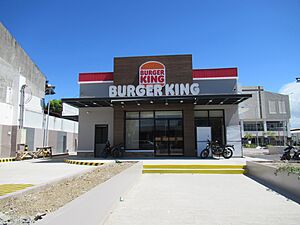
Burger King Holdings was the main company when Burger King became public in 2002. Burger King earns money from renting properties and sales from company-owned restaurants. However, a large part of its income comes from fees paid by franchisees. After 3G Capital bought the company, Alex Behring became the CEO and chairman.
Today, Burger King Corporation is a separate company that is part of RBI. RBI also owns Tim Hortons, Firehouse Subs, and Popeyes Louisiana Kitchen.
Josh Kobza became the CEO of RBI in 2023. Tom Curtis, who oversees Burger King in the U.S. and Canada, was appointed president in 2021.
In North America, Burger King Corporation is in charge of giving licenses to restaurant owners and managing the stores. In other countries, the company often works with local partners or sells the rights to a franchisee who becomes a master franchise for that area. This master franchisee then sells licenses for new stores, provides training, and makes sure the restaurants meet Burger King's standards. In return, Burger King Corporation helps with management and advertising. In 2011, 3G Capital announced it would sell many company-owned restaurants to private owners, aiming for 95% of restaurants to be franchised. By 2016, this number grew to 99.5%. RBI now says almost 100% of Burger King restaurants are owned by franchisees.
Headquarters Location
Burger King used to have its main office in a nine-story building near the Miami International Airport. In 2002, 130 employees started working there, with more moving in later. Before 2002, Burger King thought about moving its headquarters away from Miami, but local leaders convinced them to stay. Their previous office was in a different part of Miami-Dade County.
In August 2014, there were questions again about Burger King's Miami headquarters when reports said Burger King was thinking about buying the Canadian restaurant chain Tim Hortons. The merger between Burger King and Tim Hortons created Restaurant Brands International Inc.
In 2016, Burger King signed an agreement to build a new five-story headquarters building at 5707 Blue Lagoon Drive, close to its old office. In 2018, Burger King moved into this new building. As of August 2024, Burger King has over 18,700 locations in more than 100 countries and U.S. territories.
Franchise System
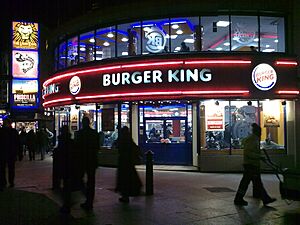
When Burger King Corporation started allowing people to open their own restaurants (franchising) in 1959, they used a system where franchisees bought the right to open stores in a certain area. These early agreements gave Burger King Corporation very little control over its franchisees, which led to problems with food quality, restaurant appearance, and how things were run.
In the 1970s, these problems with the franchise system became a big issue for Pillsbury, the company that owned Burger King. For example, Chart House, Burger King's largest franchisee at the time with over 350 locations, tried several times to buy Burger King. After these attempts failed, the relationship between Chart House and Burger King became difficult and even led to a lawsuit. Chart House eventually separated its Burger King restaurants into a new company called DiversiFoods, which Pillsbury bought in 1984 and made part of Burger King.
As part of his plan to improve Burger King in 1978, Donald N. Smith changed how future franchise agreements would work. New owners had to live close to their restaurants, which meant smaller individual owners or groups, not large companies. Franchisees were also not allowed to own other restaurant chains, so they couldn't take money away from their Burger King businesses. This new rule limited the size of franchisees and stopped larger ones from challenging Burger King Corporation, as Chart House had done. Smith also wanted Burger King Corporation to own most new locations and then rent them to franchisees. This would allow the company to take over struggling stores or remove owners who didn't follow the rules. By 1988, Pillsbury had relaxed many of Smith's changes, slowing down the growth of the brand. Neglect by new owners Grand Metropolitan and Diageo further hurt Burger King, causing financial damage to many franchisees and creating tension between them and the company.
By 2001, after almost 18 years of slow growth, the condition of its franchised restaurants started to affect the company's value. One of the most affected franchisees was AmeriKing Inc., which had nearly 400 Burger King stores. By 2002, AmeriKing, struggling with a large debt, had to declare bankruptcy. AmeriKing's failure deeply affected Burger King's value and caused delays in the sale of the company by Diageo. Diageo eventually had to lower the selling price of Burger King by almost $750 million. After the sale, the new CEO, Brad Blum, started a program to help about 20% of its franchisees, including the four largest ones, who were in financial trouble or had gone out of business.
Some individual franchisees took advantage of AmeriKing's failure. For example, Al Cabrera, a Burger King owner from Miami, bought 130 stores from AmeriKing for $16 million, which was much less than their original value. His new company, which became Heartland Foods, also bought 120 more stores from other struggling owners and improved them. This made Cabrera the largest minority franchisee of Burger King. By 2006, his company was worth over $150 million and was sold. Other buyers included a group of NFL athletes who bought 17 stores, and Dave Devoy, who bought 32 AmeriKing stores. After investing in new decorations, equipment, and staff training, many of these previously struggling stores saw sales increase by almost 20%.
As part of 3G Capital's plan to improve the company, they decided to sell all their company-owned restaurants to private owners, aiming to have 100% franchised operations by the end of 2013. This project, which started in April 2012, involved selling company-owned locations in Florida, Canada, Spain, Germany, and other areas. This move helped the company earn a profit of $68.2 million in the third quarter of 2013, compared to $6.6 million in the same quarter of 2012.
At the end of 2013, Burger King was the second-largest chain of hamburger fast food restaurants globally, behind McDonald's. By the end of 2014, Burger King was fourth among U.S. food chains in terms of sales, behind McDonald's, Starbucks, and Subway. Burger King now has over 12,000 stores worldwide.
In January 2024, Restaurant Brands International, the owner of Burger King, announced it would buy the largest franchisee of the chain, Carrols Restaurant Group, for about $1 billion. At that time, Carrols had 1,022 Burger King locations. The goal is to remodel 600 of these restaurants and then sell them back to other franchisees over five to seven years. This shows a slight change from their previous plan of having almost all franchised locations.
Global Presence
Burger King first opened a restaurant outside the main United States in 1963 in San Juan, Puerto Rico. However, it didn't have a truly international presence until several years later. After Pillsbury bought the chain, the first Canadian restaurant opened in Windsor, Ontario in 1969. Other international locations followed, including Australia in 1971 and Europe in 1975 in Madrid. Starting in 1982, Burger King and its franchisees began operating in several East Asian countries like Japan, Taiwan, Singapore, and South Korea. Due to strong competition, all Japanese locations closed in 2001, but Burger King returned to Japan in June 2007. Burger King's operations in Central and South America began in Mexico in the late 1970s, and by the early 1980s, they were in Caracas, Venezuela, Santiago, Chile, and Buenos Aires, Argentina. While Burger King has fewer international locations than McDonald's, it has become the largest chain in some countries, like Mexico and Spain.
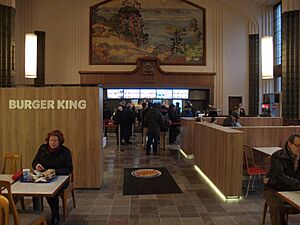
The company divides its international operations into three main areas: the Middle East, Europe, and Africa (EMEA); Asia-Pacific (APAC); and Latin America and the Caribbean (LAC). In each of these regions, Burger King has set up smaller companies to help expand into new areas. For example, in EMEA, Burger King Europe GmbH handles licensing and development. In APAC, BK AsiaPac, Pte. Ltd. manages franchising for East Asia and other areas. The LAC region includes Mexico, Central and South America, and the Caribbean Islands.
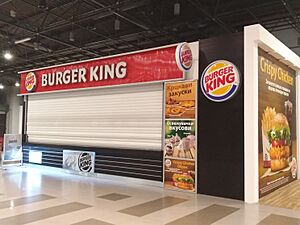
Australia is the only country where Burger King does not use its own name. When the company tried to open restaurants there in 1971, they found that another food shop in Adelaide already had the name "Burger King" trademarked. So, Burger King gave the Australian franchisee, Jack Cowin, a list of other names they already owned. Cowin chose "Hungry Jack," which was a Pillsbury pancake mix product, and added an apostrophe "s" to make it "Hungry Jack's." After the trademark expired in the late 1990s, Burger King tried to introduce its own brand to Australia but failed after losing a lawsuit against Hungry Jack's. Now, Hungry Jack's is the only Burger King brand in Australia, and Cowin's company is the master franchise responsible for operations there.
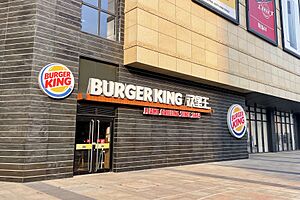
From 2008, Burger King expected that 80% of its future growth would come from expanding into other countries, especially in Asia-Pacific and India. The company planned to add over 250 stores in Asian countries like India, China, and Japan by the end of 2012. Expanding into India is challenging because many people there, especially Hindus, do not eat beef. Burger King hopes to use its non-beef products, like chicken and veggie sandwiches, to grow in that country. 3G Capital has said it will continue to expand globally to increase its profits. It's thought that 3G's connections in Brazil might help Burger King grow in Brazil and Latin America, where it has had trouble finding suitable franchisees.
In December 2020, Burger King India offered shares to the public for the first time (an initial public offering or IPO) on the Indian stock exchanges. The IPO was very popular, with people wanting to buy over 150 times the number of shares available. The stock opened at ₹112.5 per share, almost double the IPO price of ₹60, and closed at ₹135.
Animal Welfare Efforts
The way animals are treated by Burger King's suppliers has been an important topic for the company and sometimes a source of discussion.
In 2001, Burger King made an agreement with People for the Ethical Treatment of Animals (PETA) about how its chicken suppliers treated poultry. This agreement set up rules for animal welfare, including checks by independent groups.
In 2006, PETA, as a shareholder in Burger King's parent company, asked the board to use a more humane and cost-effective method for slaughtering animals called controlled atmosphere killing (CAK). In response, Burger King announced new supplier rules in 2007, giving priority to CAK and promising to use more cage-free eggs and pork from pigs not kept in crates. Animal welfare groups praised these changes as setting a higher standard for the industry.
In 2017, Burger King promised to require chicken suppliers to use healthier chicken breeds, reduce crowding in barns, improve lighting and cleanliness, and use controlled atmosphere stunning to make birds unconscious before slaughter. However, a 2023 report from Compassion in World Farming said that Burger King had not reported its progress on this promise, making animal advocates worried that the commitment was not being met.
Burger King has been praised by animal advocates for introducing a Whopper made with a plant-based meat alternative from Impossible Foods and for offering vegan menu items like the "Vegan Royale" in the UK. Burger King UK has also promised that 50% of its menu will be meat-free by 2030.
Legal Issues and Disagreements
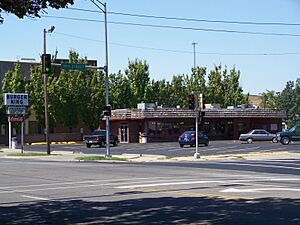
Burger King has been involved in several legal disagreements and court cases since it started in 1954. Depending on who owned the company at the time, their responses to these challenges have varied from trying to work things out peacefully to being more aggressive.
Court decisions from cases involving Burger King have helped set important rules for business agreements, the limits of franchise agreements, and ethical business practices. Many of these decisions have shaped how businesses operate today.
Name Disputes
A disagreement over the name "Burger King" with an unrelated restaurant in Mattoon, Illinois, led to a federal lawsuit. As a result, the larger Burger King chain was told not to open any restaurants within 20 miles of the Mattoon Burger King. An existing trademark by a shop with the same name in South Australia forced the company to change its name to "Hungry Jack's" in Australia. Another trademark in Texas meant the company couldn't sell its famous Whopper in some areas around San Antonio. The company was only able to open in northern Alberta, Canada, in 1995 after paying the founders of another chain also named Burger King.
International Controversies
There have been other disagreements during the company's expansion in the Middle East. Opening a Burger King in Ma'aleh Adumim, an Israeli settlement in the Israeli-occupied Palestinian territories, led to a disagreement between Burger King and its Israeli franchisee. This was due to the complex international discussion about whether Israeli settlements in Palestinian territories are legal under international law. The situation grew into a larger discussion involving different groups from many countries about following international law. Countries in the Arab League even threatened to take away Burger King's business licenses in their territories.
Other Lawsuits
On April 9, 2019, Nations Restaurant News reported that Burger King sued Fritz Management LLC to remove Burger King trademarks from 37 restaurants in South Texas after unclean conditions were found at a restaurant in Harlingen, Texas. In May 2019, the lawsuit was settled, and the franchisee, Fritz Management, kept the trademarks on all 37 units.
On November 19, 2019, a lawsuit was filed by a vegan from Atlanta, Georgia, against Burger King. The lawsuit claimed Burger King did not clearly state that Impossible Whopper burgers were cooked on the same grill as their beef burgers. This lawsuit was later dismissed.
On March 28, 2022, another lawsuit was filed against Burger King, claiming the fast food chain falsely advertised the Whopper to "look about 35% bigger in its advertising than it is in reality." On May 5, 2025, a Federal Judge allowed the case to continue, saying that the claims might reasonably suggest customers were misled. Burger King argued that differences between ads and actual burgers are normal for handmade food and standard marketing practices.
Charitable Work
Burger King has two main charitable organizations and programs. One is the Have It Your Way Foundation, a U.S.-based non-profit group that focuses on helping with hunger, preventing diseases, and supporting education through scholarship programs at colleges in the U.S. The other is the McLamore Foundation, also a non-profit, which provides scholarships to students in the U.S. and its territories.
In different parts of the United States, Burger King and its franchisees work with several charities that support research and treatment for childhood cancer. Each year, these groups hold a fundraiser called "A Chance for Kids." Burger King restaurants sell lottery-style scratch cards for $1. Each card wins a prize, usually a food or drink item, but sometimes bigger prizes like shopping sprees or trips. In the Northeast, Burger King works with the Major League Baseball team the Boston Red Sox and its charity, the Jimmy Fund. In the New York City area, it runs the contest with Burger King Children's Charities of Metro New York and the New York Yankees. Money raised in these areas goes to support the Dana–Farber Cancer Institute in Boston. In Nebraska, the company works with the Liz's Legacy Cancer Fund "BK Beat Cancer for Kids" program at the University of Nebraska Medical Center in Omaha. In the Pittsburgh area, it helped create the Burger King Cancer Caring Center, which supports families and friends of cancer patients.
Products Offered
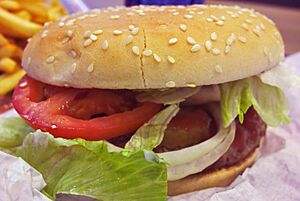
When the first Burger King restaurant opened in Jacksonville in 1953, its menu mainly had basic hamburgers, French fries, soft drinks, milkshakes, and desserts. After being bought by its Miami owners and renamed in 1954, Burger King started adding more items. The Whopper sandwich was added in 1957. This quarter-pound (about 113 gram) hamburger was created by Burger King's new owners, James McLamore and David Edgerton, to make Burger King different from other burger places. Since then, the Whopper has become very famous for Burger King and is often featured in its ads. The company even named its new small restaurants "Whopper Bars."
In 1978, Donald Smith's plan led to the addition of the Burger King Specialty Sandwich line in 1979. This new line greatly expanded the menu with many non-hamburger sandwiches, including new chicken and fish options. The Specialty Sandwich line was one of the first times Burger King tried to target a specific group of customers, in this case, adults aged 18–34, who might spend more on a higher-quality product. Another important addition by Smith was a breakfast menu, which Burger King had not offered before. Besides the Croissan'Wich in 1983, the breakfast menu was similar to McDonald's until it was updated in 1985. This update added new items like French toast sticks and mini-muffins.
As the company grew both in and outside the U.S., it introduced local versions of its products to fit regional tastes and cultural or religious beliefs. International Whopper variations might include ingredients like teriyaki or beetroot and fried egg; beer in Germany, Italy, and Spain; and halal or kosher products in the Middle East and Israel. To boost sales, Burger King sometimes offers limited-time items that are variations of its main products or new items for short or long sales periods. Items like the Texas Double Whopper and sandwiches with mushrooms and Swiss cheese have appeared on the menu for several years. However, some products, like its 1993 Meatloaf Specialty Sandwich, did not sell well and were removed.
To attract more types of customers and better compete with Wendy's, Burger King added a multi-level value menu in 1993 with items priced at 99¢, US$1.99, and $2.99. These additions were part of CEO James Adamson's plan to go "back-to-basics." The tiered menu was replaced with a more standard value menu in 1998. This value menu included items like the Whopper Jr., five-piece Chicken Tenders, a bacon cheeseburger, medium French fries, a medium soft drink, medium onion rings, and a small milkshake. In 2002 and 2006, Burger King updated its value menu, adding and removing different products like chili and its Rodeo Cheeseburger. Many of these items have since been removed, changed, or are only available in certain regions. To appeal to adults more, Burger King introduced several new products in 2003, including new or updated chicken items, a new salad line, and its BK Joe coffee brand. Some new products, like their Enormous Omelet Sandwich and the BK Stacker line, received negative attention because of their large size and high amounts of unhealthy fats. Many of these products featured higher quality ingredients like whole chicken breast, Angus beef, and natural cheeses. However, not all these products, such as the BK Baguette line, sold as well as expected.
When 3G Capital bought the company in 2010, they started a plan to change the menu, moving away from the male-focused menu of the previous owners. The first major new item was an improved version of its BK Chicken Tenders in March 2011. Over the next few months, about 20 new products were developed, and others were improved, including its Chef's Choice Burger. Eventually, they narrowed it down to 10 items, which Burger King started rolling out in the United States throughout 2011–2012, with the official launch in April 2012. The changes included new soft serve ice cream, smoothies, frappés, and chicken strips. The Whopper was the most noticeably changed product in this round, with a new type of cheese and packaging.
At the end of 2015, Burger King's parent company, Restaurant Brands International, announced that none of its companies would use chicken that had been given antibiotics that are very important for human health. This referred to a small group of antibiotics, and advocates for stopping all antibiotic use in livestock called it a "small step."
In 2019, Burger King released an "Impossible Whopper" burger, which is a vegetarian burger using a plant-based patty from Impossible Foods.
In February 2020, Burger King announced it would remove artificial preservatives, colors, and flavors from the Whopper by the end of 2020. In July 2020, Burger King announced it would start selling a Whopper patty made from cows on a diet that produces less methane gas.
In late 2021 and early 2022, the company announced it would reduce value items and change product setups due to rising prices and to make drive-thru lanes faster.
After successfully testing vegan products at temporary meat-free restaurants in Leicester Square and Bristol, Burger King UK announced in 2023 that it would offer a Vegan Royale Bakon King, made with vegan bacon, vegan cheese, and a vegan burger from The Vegetarian Butcher.
Cooking Equipment
Just like its menu, the equipment Burger King uses to cook its hamburgers has also changed over time. The burgers have always been cooked using a mechanical broiler. The first one, called an Insta-Broiler, was one of the two pieces of equipment the founders of Insta-Burger King bought before opening their first restaurant. The Insta-Broiler cooked 12 burger patties in a wire basket, cooking both sides at once. When McLamore and Edgerton took over the company, they switched to an improved "Flame Broiler." This new broiler, designed by them, had fixed burners that cooked meat on a moving chain, breaking down less often while cooking at a similar speed. The company used this type of broiler for the next 40 years.
Then, Burger King started developing a broiler that could cook different items at different speeds and times. These new units were tested in 1999 and eventually became the two models the company put in all its restaurants in 2008–2009. Along with these new broilers came new equipment to hold cooked food, with a computer system to monitor product quality. This monitoring system helps track food quality more accurately and allows the company and its franchisees to save money by better predicting sales and how much product they need.
Advertising Campaigns
Since its beginning in 1954, Burger King has used many different advertising programs, some successful and some not. In the 1970s, their ads included the "Hold the pickles, hold the lettuce..." jingle, the idea for their mascot the Burger King, and famous slogans like "Have it your way" and "It takes two hands to handle a Whopper."
Burger King was the first fast food company to use an attack ad in 1981, featuring a young Sarah Michelle Gellar. The TV ad claimed Burger King burgers were bigger and tasted better than McDonald's. This made McDonald's executives so angry that they sued everyone involved. From the early 1980s to about 2001, Burger King worked with many ad agencies that created several unsuccessful slogans and programs, including the "Mister Rodney" commercial and its biggest advertising flop, "Where's Herb?"
Burger King was also a leader in "product tie-in" advertising, where they partnered with movies or other brands. A successful partnership was with George Lucas' Lucasfilm, Ltd., to promote the 1977 film Star Wars. Burger King sold a set of drink glasses featuring the movie's characters. This was one of the first such promotions in the fast food industry and set a trend that continues today. Burger King's early success was later overshadowed by a 1982 deal between McDonald's and The Walt Disney Company to promote Disney's animated films. In 1994, Disney switched from McDonald's to Burger King, signing a deal for 10 movies, including Aladdin (1992), Beauty and the Beast (1991), The Lion King (1994), and Pixar's Toy Story (1995). Burger King also made kids' meal toys to promote the DreamWorks Pictures film Small Soldiers (1998). This caused some discussion because the movie was rated PG-13. As a result, Burger King changed its commercials to target an older audience and included a note with the toys saying the movie might not be suitable for very young children. A partnership with the Pokémon franchise in 1999, when it was very popular, was hugely successful for the company, with many locations quickly selling out of the toys. In December 1999, two dangerous incidents involving the Pokéball toy, one of which caused the death of a 13-month-old child, led to the toy being recalled.
Soon after TPG Capital, L.P. bought Burger King in 2002, the new CEO Brad Blum started to fix the company's struggling advertising programs. In 2003, Burger King hired the advertising agency Crispin Porter + Bogusky (CP+B), which completely changed its advertising with new campaigns. CP+B was known for its cool, rebellious style, which was exactly what Burger King was looking for. Their strategy focused on a redesigned Burger King character from the 1970s/1980s children's ads, now simply called "the King."
While very successful, some of CP+B's commercials were criticized for being unfair to certain groups or culturally insensitive. Burger King's new owner, 3G Capital, ended its relationship with CP+B in 2011 and moved its advertising to McGarryBowen to start a new campaign that focused on the food and aimed at a wider audience.
CP+B also created new characters like the Subservient Chicken and the fake band Coq Roq, which were featured in online ads on sites like MySpace and Burger King's own pages. These were part of larger TV and print campaigns. One of CP+B's most successful promotions was creating three advergames for the Xbox 360. These games sold over 3.2 million copies, making them one of the top-selling games alongside Gears of War. These ad campaigns, along with other promotions and new products, brought both positive and negative attention to Burger King and helped TPG and its partners earn about $367 million in profits.
When the late-2000s recession hit the 18–35 age group particularly hard, Burger King's market share dropped, and the company started losing money. After the company was sold in late 2010, the new owners ended Burger King's seven-year relationship with CP+B. They hired a rival firm, McGarryBowen, to create a new campaign with a wider market reach. As part of the new campaign, McGarryBowen stopped using The Burger King in ads and instead focused on the food and ingredients in its new advertising campaigns.
In recent years, Burger King has used advertising strategies that playfully tease its fast food rival, McDonald's. For example, one campaign offered a free Whopper to anyone dressed as a clown (like McDonald's mascot) on Halloween. Another encouraged mobile app users to go to a nearby McDonald's to get a Whopper for one cent. They also created a "The Not Big Macs" menu, making fun of McDonald's losing the Big Mac trademark in the EU.
In February 2019, the company launched an ad campaign called "Eat Like Andy." The TV ad, which first aired during the Super Bowl LIII, showed old documentary footage of the pop artist Andy Warhol (1928–1987) unwrapping and eating a Whopper. The footage was approved by the Andy Warhol Foundation. Before the game, Burger King also offered an "Andy Warhol Mystery Box" to customers who ordered it through DoorDash. This box included items like a plastic bottle of ketchup and a platinum wig so people could "Eat Like Andy."
On March 8, 2021, Burger King was criticized for its International Women's Day marketing campaign. A tweet from Burger King UK stated, "Women belong in the kitchen." Many Twitter users and news outlets called the tweets unfair. Burger King UK followed up, saying, "We're on a mission to change the gender ratio in the restaurant industry." However, critics said the initial tweet had already caused harm because it got much more attention than the explanation. After strong negative reactions, Burger King deleted the tweet 12 hours later and apologized, saying, "We got our initial tweet wrong and we're sorry."
In late 2022, Burger King released the "Have it Your Way" commercials, which became very popular on social media like TikTok after the 2022–23 NFL playoffs because they were catchy and repeated a lot. The ads gained media attention and even appeared on music streaming services like Spotify in February 2023.
See also
 In Spanish: Burger King para niños
In Spanish: Burger King para niños
- Burger King foot lettuce
- Drive-through
- Hungry Jack's, the Australian subsidiary for Burger King
- List of hamburger restaurants
- WhopperCoin
External links
- Official news & press: https://www.bk.com/news-press
- Burger King McLamore Foundation. .
- Liz's Legacy Cancer Fund BK Beat Cancer for Kids
-
- Business data for Burger King: Google Finance
- Yahoo! Finance
- Reuters
- SEC filings


